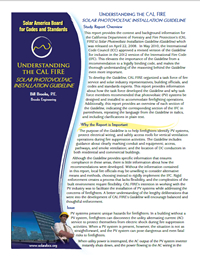
Understanding the CAL FIRE Solar Photovoltaic Installation Guideline
Download the one-page summary (PDF, 335KB) or the full report (PDF, 1.37MB).
Overview

This report provides the context and background information for the California Department of Forestry and Fire Protection's (CAL FIRE's) Solar Photovoltaic Installation Guideline (Guideline) which was released on April 22, 2008. In May 2010, the International Code Council (ICC) approved a revised version of the Guideline for inclusion in the 2012 version of the International Fire Code (IFC). This elevates the importance of the Guideline from a recommendation to a legally binding code, and makes the thorough understanding of the reasoning behind the Guideline even more important.
To develop the Guideline, CAL FIRE organized a task force of fire service and solar industry representatives, building officials, and codes and standards experts. This report provides information about how the task force developed the Guideline and why task force members recommended that photovoltaic (PV) systems be designed and installed to accommodate firefighting operations. Additionally, this report provides an overview of each section of the Guideline, indicating the corresponding section of the IFC in parentheses, repeating the language from the Guideline in italics, and including clarifications in plain text.
Why the Report is Important
The purpose of the Guideline is to help firefighters identify PV systems, protect electrical wiring, and safely access roofs for vertical ventilation operations during fire suppression activities. The Guideline includes guidance about clearly marking conduit and equipment; access, pathways, and smoke ventilation; and the location of DC conductors in both residential and commercial buildings. Although the Guideline provides specific information that ensures compliance in these areas, there is little information about how the recommendations were developed. Without the information contained in this report, local fire officials may be unwilling to consider alternative means and methods, choosing instead to rigidly implement the IFC. Rigid enforcement creates a process that lacks flexibility, and the complexities of the built environment require flexibility. CAL FIRE's intention in working with the PV industry was to facilitate the installation of PV systems while addressing the concerns of firefighters. A better understanding of the lengthy deliberations that went into the development of CAL FIRE's Guideline will encourage balanced and thoughtful enforcement.
Key Findings
The CAL FIRE Guideline begins with several pages of introductory information, including a history of the task force that developed the document, a short explanation of PV systems for stakeholders unfamiliar with the technology, a resource list for further study, and an explanation of what local governments must do to adopt the guidelines and enforce them as a local ordinance. The brief PV system background provides basic facts, including that PV systems only produce electricity during daylight hours, the typical locations of AC and DC disconnects, and that DC voltages can reach 600 volts. The introduction also describes other types of solar systems and notes that solar thermal systems for heating water or air may look similar to PV arrays, but do not present the electrical hazards of a PV system. The following is a list of the five main sections from the Guideline. These are covered in detail in this report, organized by section and indicating the corresponding section of the IFC in parentheses, the language from the Guideline in italics, and clarifications in plain text.
- Marking (IFC 605.11.1)
- Access, pathways, and smoke ventilation (IFC 605.11.3)
- Location of DC conductors (IFC 605.11.2)
- Non-habitable buildings (IFC 605.11.4)
- Ground-mounted photovoltiac arrays (IFC 605.11.4)
The CAL FIRE Solar Photovoltaic Installation Guideline is available as a free download at http://osfm.fire.ca.gov/pdf/rep orts/solarphotovoltaicguideline.pdf.
The 2012 International Fire Code can be purchased from the International Code Council store in May 2012 at http://www.iccsafe.org/Store.